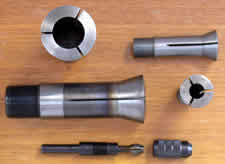Home | Glossary | Resources | Help | Contact Us | Course Map
Archival Notice
This is an archive page that is no longer being updated. It may contain outdated information and links may no longer function as originally intended.
Head-Turning Operations
The next operation finishes the exterior shape of the case head. Head turning is performed in a small automated lathe, with the cutter blade mounted at ninety degrees to the long axis of the case so that it can create all needed surfaces in one pass. When the factory switches from producing 30-30 Winchester cases to manufacturing 5.56 mm NATO cases, the cutter is changed to meet the new specifications.
The head turning machine grips the cases in a collet, a hollow die with longitudinally split walls that can grip and release a round object. When the case is fed into the machine, force is removed from the collet, allowing it to accept the next case to be processed. As the case seats, the machine applies pressure to the collet forcing it to firmly grip the case. The case and collet spin to high speed before the cutter touches the case, ensuring a clean accurate cut. The collet opens and a punch dislodges the case. Good head-turning machines will process 60 to 120 cases per minute.
Some head turning machines can also drill or punch the flash hole, which is the hole that allows fire from the primer to reach the propellant charge. If the case will be loaded (as opposed to being sold as a component), the maker will probably punch the flash hole in the case just before the primer is inserted on a device called a pierce-and-prime machine.
Additional Online Courses
- What Every First Responding Officer Should Know About DNA Evidence
- Collecting DNA Evidence at Property Crime Scenes
- DNA – A Prosecutor’s Practice Notebook
- Crime Scene and DNA Basics
- Laboratory Safety Programs
- DNA Amplification
- Population Genetics and Statistics
- Non-STR DNA Markers: SNPs, Y-STRs, LCN and mtDNA
- Firearms Examiner Training
- Forensic DNA Education for Law Enforcement Decisionmakers
- What Every Investigator and Evidence Technician Should Know About DNA Evidence
- Principles of Forensic DNA for Officers of the Court
- Law 101: Legal Guide for the Forensic Expert
- Laboratory Orientation and Testing of Body Fluids and Tissues
- DNA Extraction and Quantitation
- STR Data Analysis and Interpretation
- Communication Skills, Report Writing, and Courtroom Testimony
- Español for Law Enforcement
- Amplified DNA Product Separation for Forensic Analysts


